
Fees increase, but parks need more funding
You finally arrive at the entrance of the national park that you have only imagined in your dreams.
As you are about to take the last step crossing the threshold, a sign pops up in the corner of your eye saying that all visitors must pay a vehicle entrance fee of, say, $20.
You think to yourself for a moment ….
A fee.
“This is a national park, why would there be a fee?” you say to yourself.
You take a second and contemplate whether it worth paying. Should you just turn around and leave?
You look out at all the beauty that lies before you. You quickly realize, yes, pay the fee. You do not want to miss the incredible experience down the road.
Most people pay the fee.
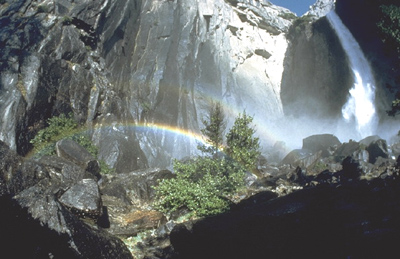 |
A waterfall and rainbow at Yosemite National Park in California (Photo courtesy of the National Park Service). |
These fees are necessary to help some of the nation’s parks with their operational costs.
And the cost of entering parks with fees will increase for visitors over the next three years, National Park Service officials announced in early May 2007.
The increases for vehicle fees and park passes will be gradually increased at individual parks across the nation at 131 of the 391 parks system units. This summer, 11 parks will increase fees. In 2008, another 84 parks and other units are expected to increase fees. And in 2009, the remaining 36 units will add a few dollars to their existing fees.
Across the nation, admission fees vary at each park.
The Great Smoky Mountains National Park and the Big Cypress National Preserve include just a couple of the many units that do not require an admission fee.
On the other hand, Fort Davis, Death Valley and the Grand Canyon are just a few among many parks that must charge visitors and their vehicles an admission fee.
In 2004, the National Park Service implemented the 80-20 rule in which a national park unit retains 80 cents to every dollar visitors pay and the unit gives the federal government only 20 cents of that dollar.
Before this rule was adopted, the entire charge for admissions was given to the federal government. Now only 20 cents of every dollar is given to the federal government for overhead of parks nationwide.
|
Water is central to life within the Big Cypress National Preserve in South Florida (Photo courtesy of the National Park Service). |
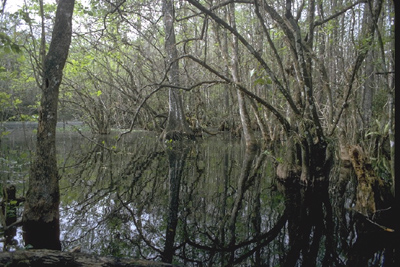 |
The general public has the choice to buy national park passes prior to visitations if they would like. Different types of passes can be purchased or obtained. The America the Beautiful National Parks and Federal Recreational Land Pass can be purchased by anyone of the general public. The pass is $80, lasts for one year, can be used at any site that charges an admission fee.
The senior pass is available for lifetime use to any U.S. citizen or resident over the age of 62 and may be purchased for $10.
The access pass is a lifetime pass available to any U.S. citizen or permanent resident that has disabilities of which can be documented. This pass must be obtained by the specific person at the park.
The volunteer pass is a free pass that can be obtained for one year for those who have volunteered 500 cumulative hours.
The system-wide national parks pass can be purchased for $50 to anyone. It is usable for entrance for exactly one year at all national parks system units. Individual parks also offer passes for a period of up to one year.
All of these passes allow admittance of the pass-holder plus all passengers in a non-commercial vehicle at those sites that charge per vehicle. At sites that charge per person, it admits the pass holder as well as three other adults.
If one does not wish to or has abilities to purchase or obtain these passes, the standard entrance fee for visitors required must be paid.
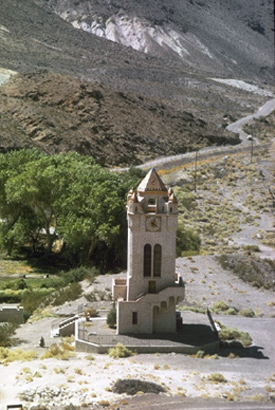 |
. Fort Davis National Historic Site in Texas (Photo courtesy of the National Park Service). |
It looks possible now that admission fees may now be creating more flexibility and benefits to parks. This has developed new questions. For example, does an admission fee benefit park over those that don’t charge?
The answer seems to be that fees help the units. The effects are significant so far. In the past decade or so, national parks have been struggling to accumulate extra money for funding, paying staff and other such basics enabling safety, cleanliness and enjoyment for visitors.
Attendance nonetheless remains the reason if a national park thrives or not. Areas specific parks lack or excel in have no relevance if visitors aren’t present. Could it be possible that admission fees hurt attendance due to some who would rather visit a park with no entrance fee?
Data have shown that the Great Smoky Mountains National Park in 2006 was ranked third in attendance, even higher than the Grand Canyon, which landed at No. 10. These data show that parks without entrance fees are as appealing for visitors just as parks with fees.
Parks without fees were ranked one and two in the 2006 NPS visitation report, therefore showing attendance may not affected by fees. The top site in visitation was the Blue Ridge Parkway and it is quite different in its design and purpose from other parks that charge fees. And the Golden Gate National Recreation Area is also unique in that it is a recreational area serving a large metropolitan area and not a traditional national park by any means.
Paul Cox, a fee program manager at the Grand Canyon National Park, said, “In 1997, the fee went from $10 to $20 and in 2006 to $25. Statistically there has been no decline in visitation.”
Agreeing with this, Bob Miller, management assistant at the Great Smoky Mountains National Park, stated, “I think it doesn’t really matter to people if there is a fee or not. In terms of people planning a vacation, paying such a small fee for an entire week of vacation if going to a park with a cover charge will probably not change the decision of which park to travel to.”
|
Death Valley National Park in California (Photo courtesy of the National Park Service). |
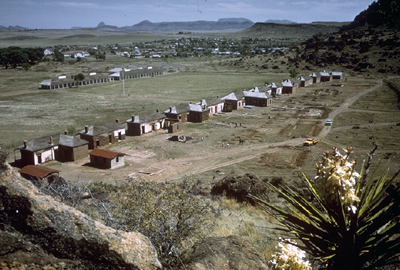 |
“If there is a fee, it should be a reasonable one, but having a fee doesn’t decrease the number of visitors in that specific park,” said Bob DeGross, chief of Interpretation at Big Cypress National Preserve.
Many of the parks that have entrance fees are beginning to witness benefits from the money now accessible to them. Revenue from entrance fees is being implemented into projects that had previously been put on hold.
“All of the money we retain goes towards something that benefits visitors. With the money we have put in a new walkway around parameter of one of the forts, which enables visitors to go see the exhibits. We are as well currently in the process of fixing an exhibit in one of the buildings too so more visitors are able to view it,” said Sam Trisler, a park ranger at Fort Smith National Historic Site in Arkansas and Oklahoma.
Katie Bablitch, an administrative assistant at Yosemite National Park in Northern California, said the money means better parks.
“Revenue from entrance fees help fund continuous improvements needed for upkeep. The cost of living keeps on increasing and there is no extra funding coming in, the same amount every year is given and doesn’t help with the increase in living,” she explained
Similarly, Terry Baldino, assistant chief of Interpretation at Death Valley National Park in California, stated that admission fees were positive.
“Having an admission fee is a good thing; partly cause of legislation passed that allows parks to maintain a certain percentage of the entrance fee. In the past, they (the fees) were turned into Washington and we didn’t see money come back to the parks individually, now they have fee demonstrations, so now Death Valley keeps 80 cents of every dollar, it goes into special account, now we can do projects that have been around for years that we haven’t had money to do things with,” Baldino stated.
John Heiner, a supervisor park ranger at Fort Davis National Historic Site in Texas, stated that “the money from admissions has been used from the fee demonstration program and it goes to fund half of one position a year, one interpretation ranger, so they can expand more services. Quite a bit of repair on the park has been done that have direct visitor effects, new exhibits have been created. In the long range in the year 2010 give or take enough revenue from admissions fees will be available to totally redo the museum.”
It can be said and equally shown that a vast amount of improvement into individual parks has become available via the parks ability to accumulate revenue from entrance fees
Though benefits can be induced through money at parks with entrance fees, this doesn’t necessarily mean those parks without entrance fees are lacking.
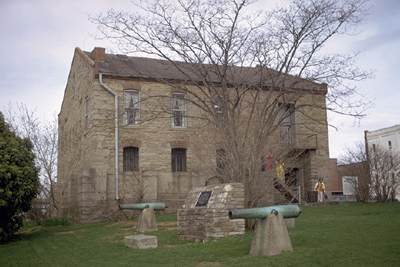 |
Fort Smith National Historic Site in Arkansas and Oklahoma (Photo courtesy of the National Park Service). |
“Parks with admission fees probably have no more benefit than those without, but the fee revenues certainly gives much more flexibility to those with fees,” Cox said.
When asked if he wished his park had an admissions fee, Miller said it would help.
“We would like to see an admissions fee. I think it would benefit the park greatly. The bathrooms need to be made handicap, so the revenue from fees would go toward that as well as trail, buildings and facilities improvements.”
DeGross added, “Obviously if you do have entrance fee and you retain it you have ability to use those fees for necessary things needed at the park, and this will give parks with cover fees some benefits.”
The more money a park has available will provide enhanced benefits regardless if there is an admission fee or not.
“If we were to have an admission fee, increasing our budget we would probably use it for changing from dispersed trail use to designated trail use which is a very important thing that needs to be implemented. As well extra money could go towards campground facilities,” DeGross said.
Admission fees are only one possible way to gain revenue for parks. Parks without admission fees still receive money from revenue distribution from the federal government.
Many parks without the privilege of admission revenue can find other ways in which to obtain funds.
“Most parks without an admission fee are very small, and can be funded by the state or federal government for upkeep,” said Bablitch.
Still, it remains unclear on whether recent benefits of parks via revenue from entrance fees will spark nationwide conversion of this habit.
“Without the funds generated by entrance fees many parks would quickly fall into disrepair and lose the ability to best serve our visitors,” Cox said.
Struggles steadily continue for the national parks to constantly insure secure incoming revenue. In future years, types of decisions made will be based on evidence from present day.
The admission fee increase announced in spring 2007 will affect 11 of the system’s parks in summer 2007. They include:
- Big Bend in Texas
- Black Canyon of the Gunnison in Colorado
- Bryce Canyon in Utah
- Cedar Breaks in Utah
- Colonial in Virginia
- Fort McHenry in Maryland
- Guadalupe Mountains in Texas
- Martin Van Buren in New York
- Mesa Verde in Colorado
- Muir Woods in California
- Zion in Utah

Comments are Closed